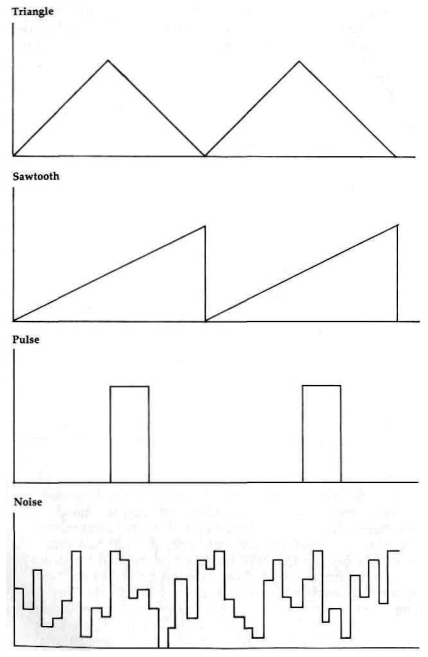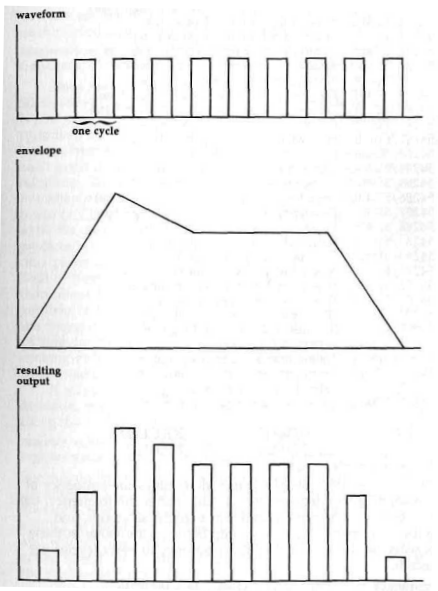SID (Sound Interface Device)
The SID (Sound Interface Device) chip, officially designated the 6581, was a remarkable breakthrough when it was first introduced in the Commodore 64. It remains the most sophisticated piece of standard audio hardware in any currently available home computer. The SID incorporates most of the features of a complete sound synthesizer in a single chip, and it has been a key to the Commodore 64’s success as a music machine.
Some sound fundamentals: Most sounds we hear are transmitted in the form of pressure waves through the air. The sounds humans usually consider pleasant have regularly repeating patterns. To duplicate (synthesize) these sounds, an electronic device such as the SID chip generates patterns of electrical signals that are passed through an amplifier to a speaker, which translates the signals into corresponding sound waves. The most rudimentary characteristic of a sound wave is its frequency, the measure of how many times per second the bask sound pattern repeats. In music, frequency is expressed as pitch. The higher the frequency of a sound wave, the higher its pitch. Frequency is measured in units of cycles per second, called hertz (Hz). The generally accepted range of frequencies audible to humans is 20 Hz to 20,000 Hz. Any computer that provides for sound output will allow you to control the frequency of the sound. For those computers like the IBM and Apple that have only rudimentary sound capabilities, frequency is the only component you can control.
In the common musical scale, every note is assigned a particular frequency. But you don’t have to know much about music to know that a C note played on a guitar sounds different from one played on a piano or flute or organ. Obviously, there is more to sound than just frequency. The next important characteristic is waveform. The sound wave for a “pure” tone will have a sinusoidal waveform, as shown in next figure. However, a sine waveform is relatively difficult to synthesize digitally, so it is fortunate that pure tones are relatively rare.

Most sounds, including the sounds of almost all musical instruments, contain harmonics in addition to the fundamental frequency. Harmonics are components of complex sound waveforms which are exact multiples of the fundamental frequency. For example, the first harmonic of a 120-hertz wave will have a frequency of 120 Hz (the fundamental frequency). The second harmonic will have a frequency of 240 Hz, and the third harmonic will have a frequency of 360 Hz. Any wave shape can be expressed in terms of a fundamental sine wave and additional harmonics. The SID can generate three different wave shapes: the triangle, which corresponds to a fundamental frequency plus odd harmonics in diminishing proportions; the sawtooth waveform, which corresponds to a fundamental frequency plus both odd and even harmonics in diminishing proportions; and the pulse waveform, which has a varying mix of harmonics depending on the width of the pulse
Next figure illustrates these waveforms. The triangle waveform corresponds to mellow sounds like those of the xylophone. The sawtooth waveform corresponds to the slightlyharsher sound of instruments like the guitar or accordion. Because the harmonic content of the pulse waveform is variable, it can be used for a variety of sounds ranging from piano to trumpet.
Note that next figure includes a fourth waveform not previously mentioned. In addition to the “orderly” waveforms, the SID can also produce a waveform that varies constantly with no discernible frequency. Such a pattern (or lack of pattern) is characteristic of the class of sounds we call noise. Depending on how fast the wave changes levels, it can range from a low buzz to a high hiss like radio station static.

The final component of sound that can be controlled by the SID is the envelope. If you visualize the sound waveforms as shown in previous figure, the volume of the sound corresponds to the height of the waveform, technically called the amplitude of the wave. While some instruments like the organ can start a note playing at a constant amplitude (volume) and turn it off almost immediately, most instruments take a certain amount of time to bring a note to full amplitude, and in some instruments a note will linger for a brief period after it has been played. This rise and fall of amplitude is called the envelope of the waveform, and is usually described in terms of attack, decay, sustain, and release (ADSR), as illustrated in next figure. Each class of instrument has a characteristic ADSR envelope.

The attack is the time required for the note to rise from silence to maximum volume after it is begun-for example, after a string is picked or bowed or struck. Decay is the time required for the note to drop from maximum volume to its sustain level, where it remains until it begins to die away to silence again (the release phase). Not every sound will exhibit every phase of the ADSR envelope. For example, the envelope for instruments like the guitar or piano which have plucked or struck strings will have almost no attack time; the envelope for instruments like the flute, where the player must start a column of air vibrating, have a significant attack time. The discussion of the ENVELOPE statement in the System Guide that came with your 128 shows the relative ADSR parameters of a variety of instrument types. If you are confused about the relationship between frequency, waveform, and envelope, next figure should help clear up some of the confusion.

Here you can find the lists of the available registers of the SID chip. A detailed description of each follows. The SID’s 29 registers fall into two distinct classes. The first 25 are write-only; reading from them returns zeros or meaningless values. The final 4 are read-only; writing to them has no effect. All 128 SID registers appear in the same locations and have the same functions as the Commodore 64’s SID chip. Thus, any Commodore 64 sound routine should also work in Commodore 128 mode. In addition to being loaded directly, some of these registers can also be loaded indirectly from shadow registers as part of the BASIC IRQ service routine.